Glasstire staff and contributors share which Texas-based shows, events, and works made their personal “best” lists for 2018.
****
Christopher Blay
Walls Turned Sideways: Artists Confront the Justice System at the Contemporary Arts Museum Houston
“What is the social role and responsibility of the artist in times of political urgency?” Guest curator Risa Puleo poses and answers this question at the CAMH with selections from 40 artists including Chris Burden, Andrea Fraser, and Glen Ligon. (On view through Jan. 6, 2019) Puleo flays the ultra-flawed justice system with works from the participating artists, laying bare all the layers of its structure, from policing, to incarceration and probation. Carl Pope’s From the Trophy Collection…, a table of trophies he created for police officers involved in extrajudicial killing of black men, is a sharp and cynical jab to the system.
FOCUS: Njideka Akunyili Crosby at the Modern Art Museum of Fort Worth
Njideka Akunyili Crosby’s Counterparts (on view through Jan. 13, 2019) are mirrored pairs of paintings juxtaposing life in America with life in Nigeria, which she left in 1999. The works are rich collages of fabrics, solvent transfer prints, and paintings that magnify the cultural impact of colonialism and pop culture on indigenous populations across western Africa. Some of the cultural impressions are humorous, like the iterations of Michael Jackson’s Thriller jackets on album covers of Nigerian tribute bands. Others are ominous. In the pair of paintings As We see You, two Blackmoor serving dishes are around the necks of slave figurines, fetishizing a colonial past.
Lillian Young’s BFA thesis show, TCU’ s Moudy Gallery, Fort Worth
It’s rare that a BFA exhibition rises above an aspirational artsy gesture that makes a political statement and doesn’t elicit an eye roll. And if you blinked last month, you probably missed this one (the show was up for one week). Lillian Young’s graduating thesis show at TCU was ambitious and poignant. Among the works Young created was a series of portraits on untreated canvas of young black children killed by police and by racial violence. Black lines of paint covered their eyes — redactions that played in other works in a really good show.
****
Robert Boyd
Captive Sojourn and the Indefinite, Kaneem Smith at Galveston Arts Center
Kaneem Smith draws on Galveston’s history as a major 19th-century port. Much of the work is made out of burlap bags used to ship coffee, including an enormous curtain called Migrant Barrier Tapestry displayed in the back wall of the large downstairs gallery.
Galveston was one of the largest cotton exporting ports in the world, and Smith references the history of black Americans engaged in the back-breaking work of picking cotton. The literal centerpiece of the show is Cotton Belt Memorial, which recreates the famous abolitionist image of the 1788 slave ship called Brooks. This huge floor piece uses sewn-together burlap bags as a base, and combines casts of human bones and railroad ties in the place of the images of bodies from the original Brooks image. It is a powerful memorial work. (On view through Jan 13, 2019.)
Right Here Right Now at Contemporary Arts Museum Houston
Right Here Right Now at the CAMH this past summer included works by Albert Alvarez, Richard Armendariz, Julia Barbosa Landois, Christie Blizard, Sarah Castillo, Lisette Chavez, Adriana Corral, Ana Fernandez, Audrya Flores, John Hernandez, Diana Kersey, César Martínez, Michael Martínez, Martha Mood, Katie Pell, Chuck Ramirez, José Luis Rivera Barrera, Daniel Rios Rodriguez, and the duo of Britt Lorraine and Kristy Perez (known together as Saintlorraine). It was part of a series of CAMH shows featuring local artists, but this time the remit expanded the “local” to include San Antonio.
What knocked me out was the amazing selection of paintings and drawings and objects with a decidedly thoughtful, ‘low-brow’ feel, particularly Albert Alvarez’s grotesque depictions of street life and John Hernandez’s Big Daddy Roth-inspired paintings and sculptures. I would add César Martínez’s portraits and beer-bottle label collages, and Ana Fernandez’s exquisite neighborhood paintings. You don’t see this kind of grounded and immediate work being done much in Houston, which is a shame.
Eternal Now, Nestor Topchy’s installation at Geo. H Lewis Funeral Home, Houston
For one night only, at an established funeral home, longtime Houston artist Nestor Topchy displayed hundreds of small portraits done in the traditional style of Russian Orthodox icons — egg tempera and gold leaf. Instead of religious figures, Topchy paints portraits of artists and people in the Houston art community. Hundreds of his icons were installed along the chapel walls, and some of his International Klein Blue pieces (another of Topchy’s bodies of work, pictured at top) were scattered about. A live string quartet played, and artist Y.E. Torres, dressed in a mermaid costume, lounged under an aquarium in the funeral home’s entryway. If Andrei Rublev made Gesamtkunstwerks about Houston, he’d be Nestor Topchy.
Clothes abandoned on the streets of Houston
If you walk around Houston with your eyes open, you see many things that look sort of like art, despite any sense of artistic intention. Houston artist Nathaniel Donnett posts pictures of such scenes on Instagram, with the hashtag #HoustonTopSculptors. I contribute my own photos of such things on Instagram. For some reason, people leave items of clothing all over Houston’s streets. I always notice this, and started taking pictures of it a couple of years ago. I like imagining the stories of how the clothes ended up on the street. I don’t have a particular hastag for this kind of unintentional artwork, but perhaps I should. #softstreetsculpture, perhaps?
****
Colette Copeland
Dalí: Poetics of the Small, 1929–1936 at the Meadows Museum, SMU, Dallas
This exhibition (on view through Jan. 6, 2019) surprised me with its understated elegance. Featuring small paintings from a seven-year, prolific period of Dalí’s career, the exhibition highlights the artist’s visionary and technical mastery. Exhibiting small works is a challenging endeavor, as high ceilings and empty wall space can easily overwhelm the art, so the design and curatorial team took a risk by hanging each work with immense space around it. This installation allows for intimate contemplation of each work in an environment that feels sacred. It’s a show that I could return to many times.
Takashi Murakami: The Octopus Eats Its Own Leg at the Modern Art Museum of Fort Worth
This show promised fun and spectacle and did not disappoint on either count. But particular aspects of the show won me over. One, the exhibition showed Murakami’s early work, predating his creation of his signature, anime-inspired characters. The early work itself was mostly unremarkable, but within the context of his artistic career, it shows a radical shift in his cultural and artistic practice. Another was the inclusion of his most current and somewhat unresolved work. It deviates from his confident, colorful and highly polished sculptures and paintings, and leaves viewers with questions. A third thing I appreciated about this show was that this high-profile celebrity artist talked to Fort Worth art viewers openly, with real vulnerability, as he expressed doubts and insecurities about his practice and work.
Laurie Simmons at the Modern Art Museum of Fort Worth
I admit to a strong bias, since I have been a long-time fan of Simmons’ work. What I really appreciate about this retrospective (on view through Jan. 27, 2019) is the inclusion of work from all of her series from the last 40 years. This is a comprehensive look into an important artist who uses photography to provocatively examine issues of gender and culture. While she’s best known for the iconic work using dolls and miniatures to examine archetypal female roles, her current work explores the fetishized gaze and the masking of online identity. Simmons’ themes continue to be salient in our current political climate.
****
Hannah Dean
The fall Texas Tech University School of Art Faculty Exhibition at Louise Hopkins Underwood Center For the Arts, Lubbock
I didn’t expect to love a group show with no set theme. But sculptor Cody Arnall’s ridiculous and tediously crafted magic marker made from “thank you” grocery bags being perpetually inflated was weird and wonderful. Printmaker Sang-Mi Yoo’s cookie-cutter house stencil with a technicolor-striped ground was saccharin-sweet and acidic. Jewelry Professor Robly Glover’s Stop, a necklace composed of whistles, is, like, the anthem-piece for 2018. These art professors are in the game, churning out killer stuff. This exhibition showcased the driving force behind the experimental fervor and work ethic of the Lubbock art scene: It’s studio education.
Zach Morriss at 5&J Gallery at CASP, Lubbock
I’m still thinking about this solo show from last spring, and the themes Morriss touched on are still reframing the way I look at installation. The familiarity of suspended dresser drawers, a mantle, a rococo chair, and computer cords made for an odd call to contrition about our use of technology, self-presentation and consumerism. Beyond weighty conceptual concerns, Morriss handled painting, installation, and sculpture with certainty. Keep your eyes on this one, folks.
Rembrandt at The Citadelle Art Foundation, Canadian
The is the first time this body of work has been shown in Texas. Rembrandt was of course the absolute master of gesture, delivering the most accurate information in as few marks as possible. Exposed toes, screams at the abyss, the postures of the displaced and the despondent — these present the humanity of each person at the forefront of any other conceptual device. Rembrandt’s sympathetic view of his subjects is balanced by his dark humor: he features a man pissing, exposed bellies, or banalities like a remark on the weather — “tis vinnich kout!” This exhibition was a highlight of my year, but probably the past decade, too. Plus, no long lines in this oil-patch town.
****
Neil Fauerso:
Jenelle Esparza at Artpace Summer Residency, San Antonio
The best show in the best Artpace resident exhibition of the year, Esparza’s inventive, icy, and symbolically rich Gathering Bones fearlessly examined cotton, a historically charged plant, and its legacy of violence and subjugation. Esparza’s method is visually subtle — symbols such as cotton pods and garden hoes are encased and lit like medical instruments in a surgery theater. Abstract tapestries made from cotton hang next to resin-stained driftwood from a nearby lake that resemble raw sinew and muscles. This creates a magnificent montage of heightened symbolism and association, akin to the work of filmmakers Maya Deren and Chris Marker.
Stalker at Austin Film Society
I obviously have to include this given that, in writing or in person, I reference this movie at least once a month. The always wonderful Austin Film Society screened a 4K digital restoration of the 1979 film this past summer, and it singlehandedly convinced me that a digital print can equal a pristine film print. Tarkovsky is the greatest filmic artist to ever live; his preternatural fluency with the language of film is a perfect instrument for his symbolic instincts. Tarkovsky and several crew members contracted cancer from filming in an irradiated site, which in the movie is the scene of the mysterious Zone, where things are a notch off and one’s innermost desires are fulfilled. Thus, Tarkovsky literally died for this film. Stalker is a dreamy sci-fi odyssey that treats questions of faith, reason, desire, and God with utmost rigor, and reaches a state of a philosophical, heuristic fable. Would you really want your innermost desires fulfilled?
Monarchs: Brown and Native Contemporary Artists in the Path of the Butterfly at Blue Star Contemporary and Southwest School of Art, San Antonio
The epic, two-venue Monarchs show divided between Blue Star and Southwest School of Art (still on view, through Jan. 6, 2019) takes an au courant curatorial concept — and an ecological, science-related thread — as its launching point and luxuriates in the allegorical idiosyncrasies, chance, and history of the migratory pathway of butterflies and applies it peopled migration. Monarchs is electrically expansive, with a wide range of Latin American and Native American artists working in concert and meditation on geography and identity. Some of the work is wondrous, or devastating, or both.
****
Gene Fowler
I’m wildly unable to select favorites from the intriguing work I wrote about this year, so if I may I’d like to offer a holler to a couple of peops who recently departed their mortal hosts. The Rev. Goat Carson, known as David Carson while growing up in Irving in the 1960s, died this summer in New Orleans. While some who knew him much better than I did caution against believing everything one reads about his intriguing trajectory, if even an iota is true it’s… well, consider Kinky’s testimony that Goat was “a visionary, a veteran soul imbued with a deep, mystical nature that often manifested itself precisely when the chips were down.”
In 2011, Goat joined his brothers, filmmaker L.M. “Kit” Carson and artist Neke Carson, for an exhibition/performance/film screening at NYC’s Gershwin Hotel entitled Three Carsons Out of Texas. The late director and screenwriter Kit (David Holzman’s Diary; Breathless; Paris, Texas) showed excerpts of his Africa Diary. Neke screened a film about his 1970s portrait of Andy Warhol, in which he famously grasped the brush with his rear end. Songster Goat did a spoken-word piece about foul 1950s deeds of the Atomic Energy Commission. “Stay young in your minds, people. Keep a teddy bear close to your heart,” Goat counseled in a video in which he clutches a teddy bear. “They can’t crush you if you’re in the spirit of childhood.”
For many years before his November 15 death at age 97, Delbert “Sleepy” Read of Keene invited the public to watch him paint abstract works and rural landscapes in Cleburne’s downtown Wright Plaza mall. His work can be seen today at Keene’s Southwest Adventist University and Cleburne’s J. N. Long Cultural Arts Complex and Chaf-In Restaurant. Son Stylle Read’s history-themed murals can be seen all over the state, including the organic oddity of Cleburne’s recently-opened Gone With the Wind Museum and Gift Shop.
****
Betsy Heute
Emilý Æyer and Traci Lavois Thiebaud at Private Eye Gallery, Houston
It was one of those soulless, sweltering summer nights in Houston — the kind where all the art assumes that the people who take it seriously have left town, relegating those of us who are left to the most cynically commodified crap. After attending opening after opening after opening of said crap, a friend and I finally landed at an event at Private Eye Gallery that looked more like a parody of goth than an art opening. We were skeptical, but I’m glad we stuck it out. Emilý Æyer and Traci Lavois Thiebaud’s performance — haunting, bombastic, crystalline, confrontational, sexy, queer, intertwined, and broken — was tender and intimate and strange. Any Shitty Sedan (2018) saved me that night.
Virginia Lee Montgomery at Moonmist Gallery, Houston
The surrealist qualities of Montgomery’s Deep See are a red herring, because it lulls us into a sense of passiveness. Where surrealism so often co-opts womanhood (particularly women’s bodies) as the object of male desire and auto-eroticism, in Deep See, we feel with a sense of unease and nausea the heightened intensity of an oceanic dreamscape penetrated by drills, and a dangling braid ready to be grabbed or chopped off — or to simply and perpetually dangle.
Courtney Sanborn at Redbud Gallery, Houston
Sanborn has stated that these embroidered works spring from personal experience, and the aesthetic choices derive anywhere from illuminated manuscript to rug patterns. But the works in total — with the lush greenery and nudes — read as some kind of warped Adam and Eve story told from a contemporary woman’s point of view. It’s as if a gleeful, mischievous Eve was bouncing around, blowing fire out of her vagina and wreaking havoc at poor Adam’s expense. I laughed out loud when I saw this show.
****
Melissa L. Mednicov
Ellsworth Kelly’s Austin at UT Austin
One of my best art experiences in 2018 was the debut of Ellsworth Kelly’s long-awaited, stand-alone Austin. I visited the space on a very hot day in July and the combination of Kelly, color, and possibly the air conditioning overwhelmed my senses. I was ready to love Austin, which is the only Kelly site of its kind. The interior was a respite on a scorching day, but its invitation for quiet and reprieve, I imagine, may sustain my affection for the space year-round.
Additionally, I saw Ancestral Modern: Australian Aboriginal Art from the Kaplan & Levi Collection at the Blanton Museum of Art, also on UT’s campus, on the same day. Both that exhibition and Austin invited questions about modernism, abstraction, and meaning, particular to how the spiritual specifically appeared in some of the Aboriginal artists’ works and the tensions of its appearance and disappearance in Austin.
The Reopened Menil Collection, Houston
Another best for me was the reopening of the Menil Collection this fall. Over the summer I read William Middleton’s Double Vision (Knopf, 2018), a biography of Dominique and John de Menil. “Re-seeing” their collection, after reading more about the history of the couple, institution, and Houston, encouraged for me a new experience of the space and the permanent collection. The recent addition of the Menil Drawing Institute, spare and elegant as a building, already seems at home on the Menil campus. Its inaugural show The Condition of Being Here: Drawings by Jasper Johns is a compact yet comprehensive focus on Johns’ drawings and an intelligent introduction to the new exhibition space.
****
William Sarradet
Postcolonial, 3636 University Street, Dallas
Like a shady backroom deal, this show got swept into the shape of an obscure memory before spring broke into summer. Christina Rees’ review of the show approximates the experience. And though this was a disappointing grab at spicing up a real-estate open house for an uninspiring property in one of Dallas’ pricier neighborhoods, my impression of the show and its resonance remains true today: Some of the best conversations I’ve had about art in Dallas happened at this awkward opening.
Truth: 24 frames per second at the Dallas Museum of Art
Trailing into the first moments of 2018, this big video show ended with a week of free admission to the museum. Is that customary for the DMA? I heard some mumbling complaints about the inescapable sound bleed in the ambitious installation, and I have to agree. But the selection was solid, and I caught myself asking questions I hadn’t asked before. For what it’s worth, I saw the instant-classic work Love Is the Message, The Message Is Death, by Arthur Jafa, for the first time at the DMA in this show before I saw it at the Hirshhorn in DC, both in this calendar year. And for me — yes, it made a difference.
Shelby David Meier at Culture Hole, Dallas
These happenings, often unwittingly the punctuation to the opening or closing of a Power Station show (Culture Hole resides within the Power Station), are a local favorite. For this installation, Dallas-based artist Shelby David Meier made excellent use of an elaborate set produced for a Power Station show, and its endpoint was a simple, functional “Omellette [sic] Bar,” with accommodation for one.
Grojean Glass Studio, M Streets, Dallas
I made a visit to Grojean Glass Studio in Dallas this summer, shortly after my stint filming glassblowing demos for the Pilchuck Glass School in Washington state. Artists who moonlight as restorers inspire me. The studio, with its collection and dedication to sustaining local, vintage leaded glass is a Dallas treasure.
****
Christina Rees
Michael Menchaca at Ruiz-Healy Art, San Antonio
Every trip I make to San Antonio is a good one, art-wise, but this show stands out for me for 2018. San Antonio native Michael Menchaca’s solo show Vignettes from San Antonio at Ruiz-Healy last spring struck me as both joyful and defiant, and a visually satisfying bid to shift an aesthetic and cultural dialogue around Chicano and Latinx art. In his large collages and drawings, Menchaca combined San Antonio iconography with Mesoamerican motifs and a deep appreciation for narrative and storytelling, along with a visual nod to early video games and graphic-novel illustration. These works practically vibrated off the walls with the combined energy of his ultra-populated scenes. Menchaca has a current show up at San Antonio’s McNay, through January 6, as part of the museum’s series 100 Years of Printmaking in San Antonio.
Transborder Biennial 2018 / Bienal Transfronteriza 2018 at the El Paso Museum of Art (EPMA) and the Museo de Arte de Ciudad Juárez (MACJ)
Over the summer, two institutions on both sides of the Texas-Mexico border held their collaborative (and fifth) Transborder Biennial. Rainey Knudson and I attended both, on a day, by walking back and forth across a border bridge from El Paso to Juarez, and we were both struck and touched by the efforts of these museums’ staffs, and of course the artists in the show, to communicate a hope and synergy happening between artists on both sides of the border (the show is an open call to all artists living within 200 miles of the U.S.-Mexico border). This version of the Biennial featured 32 artists and collectives, with work by nearly every artist represented in each institution. FYI: The Museo de Arte de Ciudad Juárez (MACJ)’s building is a gem of mid-century brutalist architecture by Pedro Ramirez Vazquez, built in 1963. The museum itself could well be nicknamed “The Little Museum that Could,” given the space’s lack of practical resources and regular audience in what was even recently considered a murder capital. Here’s hoping for a long-running tradition, and I’m very much looking forward to the next Biennial.
Goya at the Kimbell Art Museum, Fort Worth
(This show is still on view, through Jan. 6, 2019) It makes some sense that this exhibition would make an impact on me, given that it was about 25 years ago that I stood in the middle of the Prado in Madrid, swooning at the overwhelming output of the old masters, and decided I wanted to write about art. Francisco de Goya y Lucientes has been a touchstone for me all along, but this show of his works on paper (borrowed from the Museum of Fine Arts, Boston) wows me all over again: Goya’s psychological insight — expressed in simple and gorgeous mark-making — to human cruelty, folly, and comedy emanates from his every small composition in this darkened and intimate museum setting. From drawing to drawing, the individual narratives sing, and the rest of the world just sort of disappears as you wander from one to the next. It entertains repeat visits. Goya in Black and White features works from Goya’s best known series, including The Sleep of Reason Produces Monsters; Disasters of War; Disparates; Tauromaquia; and Caprichos, and given our current political climate, every work feels as fresh as this morning’s news headlines. In other words, it’s a sometimes queasy show. But I would expect no less from this master.
****
Brandon Zech
Houston’s Re-examination of its own Art History
The fall of 2018 marked a boom in the Houston art community’s capacity for self-reflection. While there are venues and groups around town dedicated to the city’s rich art history — who day-in and day-out do the thankless job of reminding us where we and our art came from — the release of Pete Gershon’s book, Collision: The Contemporary Art Scene in Houston, 1972-1985 was the catalytic event that really brought the city’s art history back into some sense of the zeitgeist.
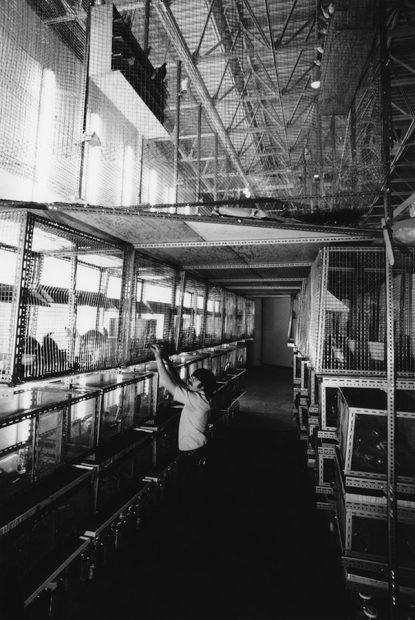
Installation view of Ellen Van Fleet’s ‘New York City Animal Levels’, March 1972, Contemporary Arts Museum Houston. MS690 Woodson Research Center, Fondren Library, Rice University.
As a city, Houston has a tendency to forget (or ignore) where it came from. The no-zoning chaos that make the city’s landscape so near-and-dear to our hearts also has a dark side, in that we praise the new while too easily burying our past. I feel that this year I saw Houston artists, collectors, patrons, and art enthusiasts of all ages digging beneath the surface to uncover a history that, to different people, was either forgotten, pushed away, or unknown. Spaces across city — including marquee venues like the Museum of Fine Arts, Houston — hosted shows of works by artists who essentially laid the foundations of the contemporary art scene that we all enjoy here today.
For a long time, I’ve felt that many younger Houstonian artists weren’t aware of their predecessors. I believe the same could be said for the major cities across Texas. Having an art historian or archivist willing to do the substantial legwork of compacting an art history into a distilled tome (even if it can’t be the whole story) is a privilege.
Laura Gutierrez’s performance Center Aisle Blues for CounterCurrent 2018, Houston
To date, I’ve only seen one piece of performance art in a supermarket. Yet the supermarket is a perfect set-up for performance: Rows of rainbow colored packages; music playing over an intercom system; strangers slipping by one another in forced interactions; shiny patterned floors. It’s contradictorily the most sterile and most ‘real’ setting you can propose.
For the 2018 CounterCurrent festival, New York and Houston-based performer Laura Gutierrez presented a 45-minute semi-choreographed wandering through Houston’s Midtown Fiesta Mart. Shadowed by an art audience and perplexed shoppers alike, Gutierrez’s playful interactions with products and people were refreshing. The performance didn’t feel forced, and instead highlighted the humorous energy of its setting. It was very much like a game, with Gutierrez swiftly dodging and evading the audience’s gaze, only to offer quick and graceful movements before running away down a different aisle. This was a special performance, and I’m happy I had a chance to see it.
NKAME: A Retrospective of Cuban Printmaker Belkis Ayón at the Station Museum of Art, Houston
Each year, the Station Museum of Contemporary Art in Houston presents a program of poignant, pertinent exhibitions that address the the world we live in. And this year, one show in particular stood out to me: An exhibition of prints by Cuban artist Belkis Ayón.
The stunning installation, which took Ayón’s large-scale collographs and turned them into room dividers and altars, highlighted the confrontational aspect of her subject: The all-male Afro-Cuban Abakuá secret society. In her creation of icons around the society’s origin story, Ayón has prioritized the voice of a princess who had originally been condemned to death, turning the group’s machismo on its head.
Ayón’s work can touch viewers who have no knowledge of the Abakuá society. Her black-and-white images are so compelling that they act like hieroglyphs, telling the story to any semi-attentive visitor. Ayón’s mastery of the collograph technique is something that cannot be accurately communicated through pictures or words; for this reason alone, I’m thankful that the Station brought this show to Houston.
Nick Weddell at the East Side Pot Shop, Austin
Little did I know when walking into Austin’s East Side Pot Shop this past spring, while it was still very new, that I would see one of my favorite shows of 2018. The installation of work was simple in the small space — an assortment of oddly shaped, goopy, pleasing vessels situated on a single shelf stretching around a rectangular room (which is really more of a walk-through space to the building’s ceramics studio).
Every piece in the show (all functional cups — a detail important to Weddell’s practice) was a knockout. The pieces teetered between sculpture and practical functionality in a really fun way, with each vessel begging to be held. Weddell has this unique ability to infuse every work he makes with a different personality. While we art viewers project ourselves into the folds, nubs, and intricacies of form that bear resemblance to the corporeal in art, Weddell’s work goes beyond this, turning clay into aliens that won’t be grounded in our world.
Honorable mentions: Jean (Hans) Arp at the Nasher in Dallas; Helen Altman at the Tyler Museum of Art.


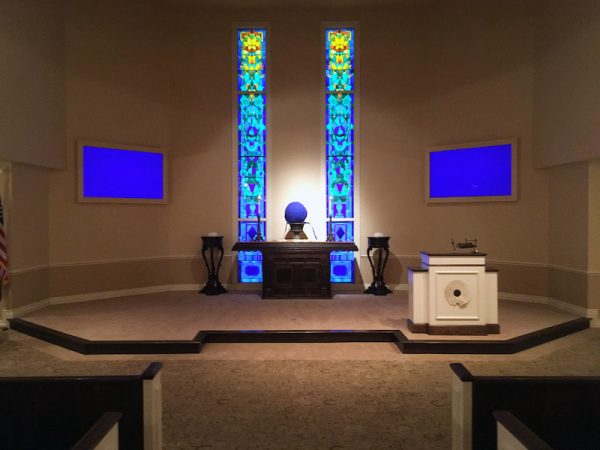
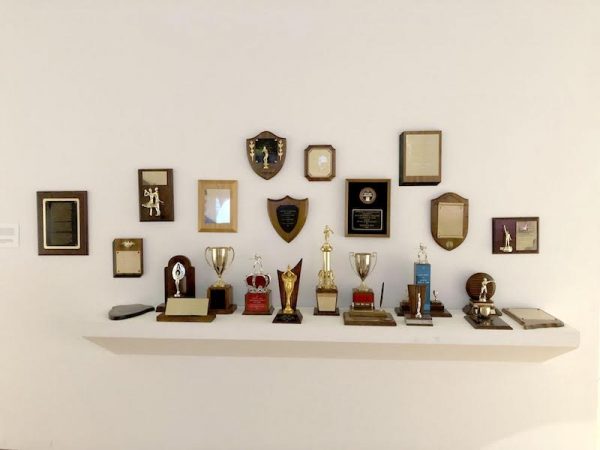
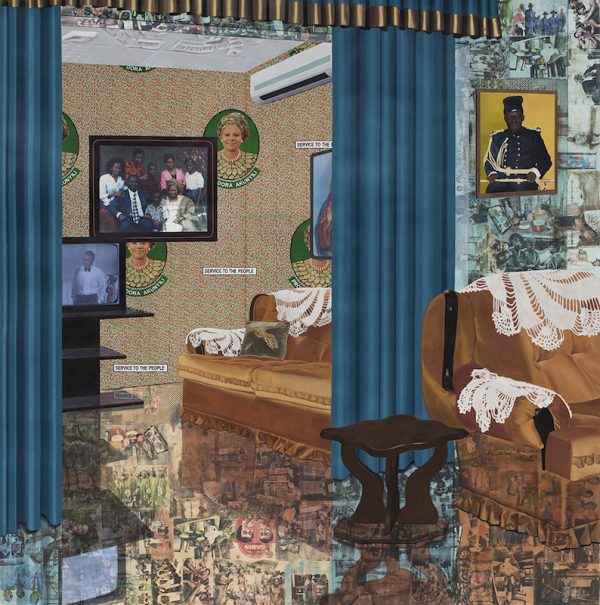
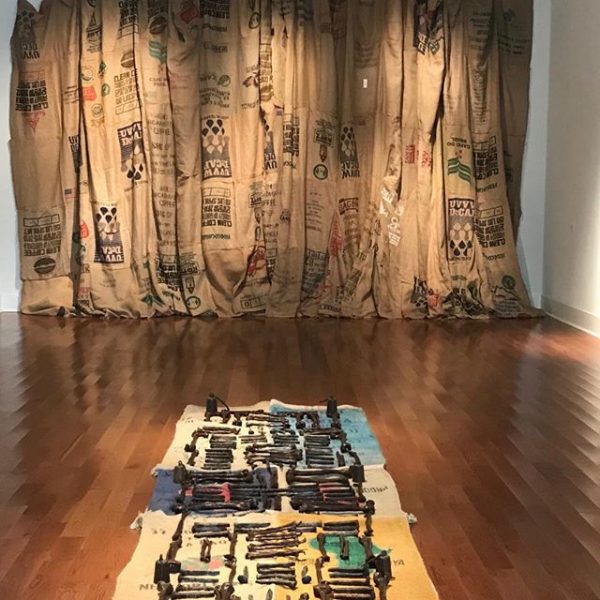

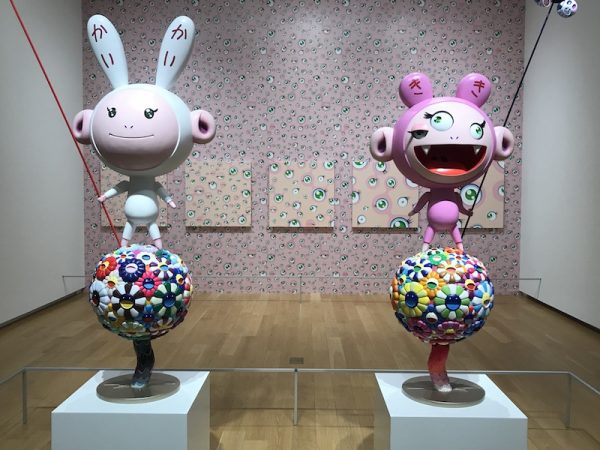
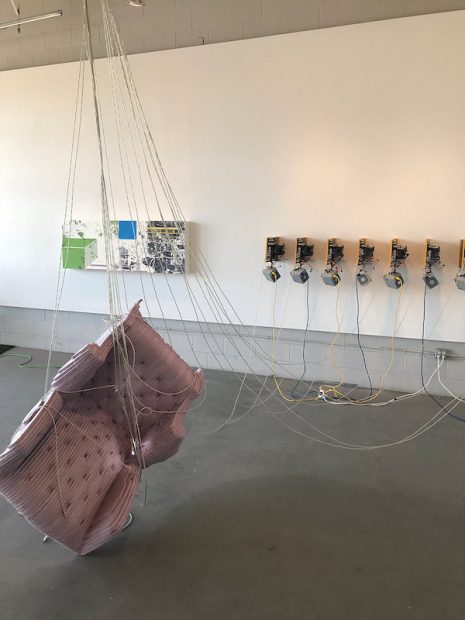




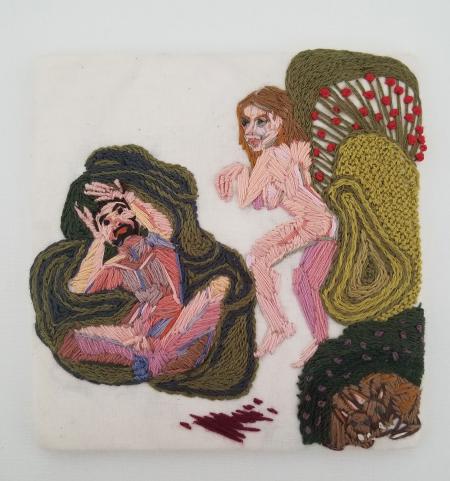
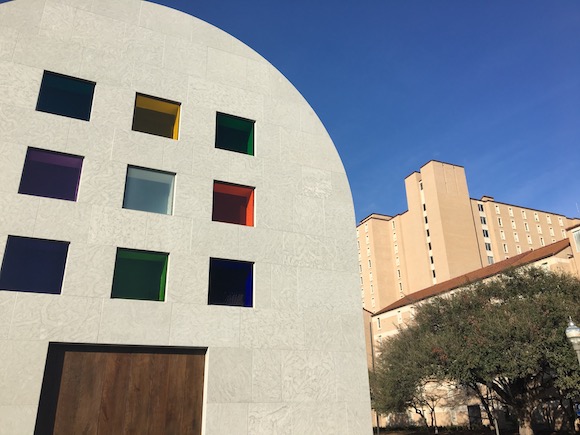
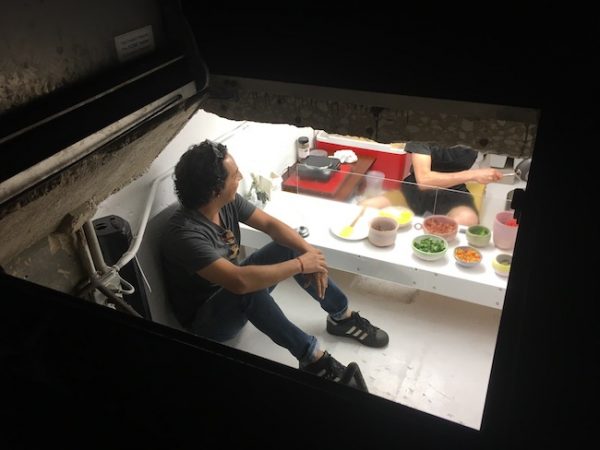
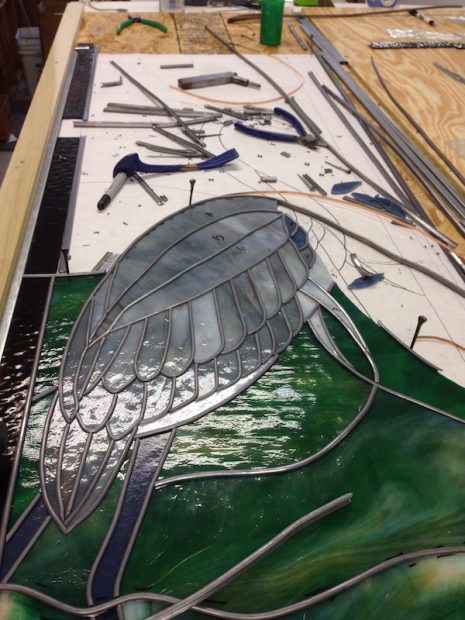
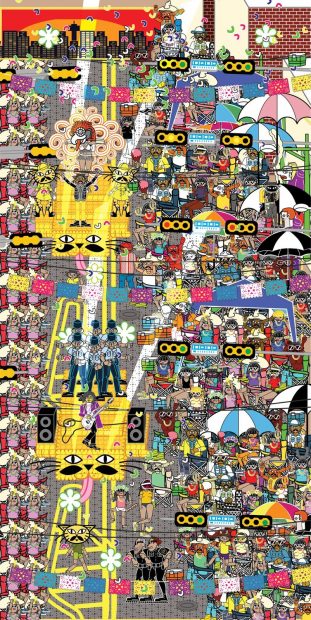
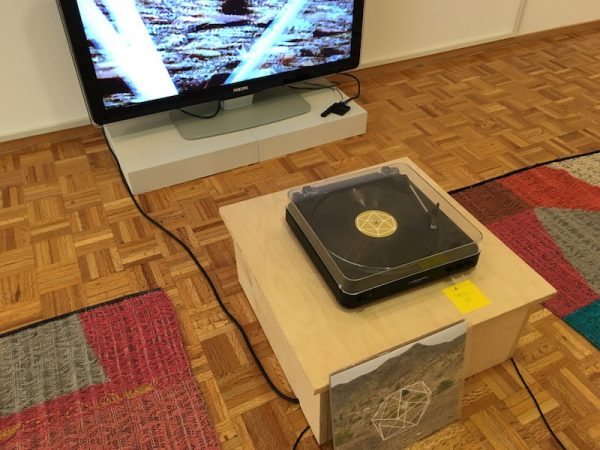


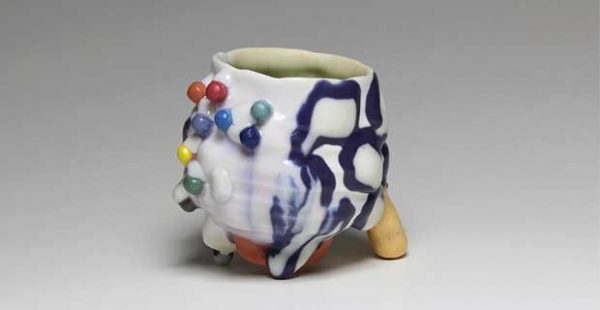

4 comments
austin! squeaked by in there 🙂
This year Austin’s visual art scene has fallen off the map. This comes at the time when The Contemporary Austin has raised more money than any time before.
What gives?
Austin has had some very poignant and impressive shows, but you have to look beyond the bigger institutions to the smaller galleries like the ICOSA Collective, Dimension Gallery, Big Medium, Grey Duck, Women and Their Work, DORF and you will find some incredible artists hard at work.
Alyssa,
What specific Austin exhibitions should have made it to Glasstire’s Best of 2018 from “smaller galleries”?